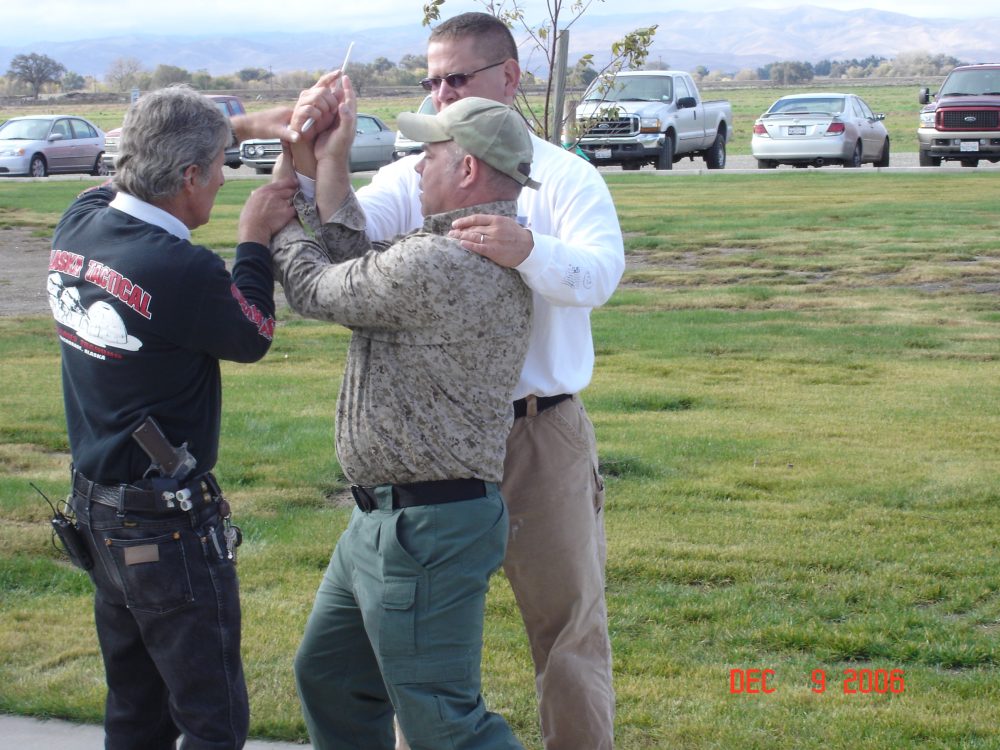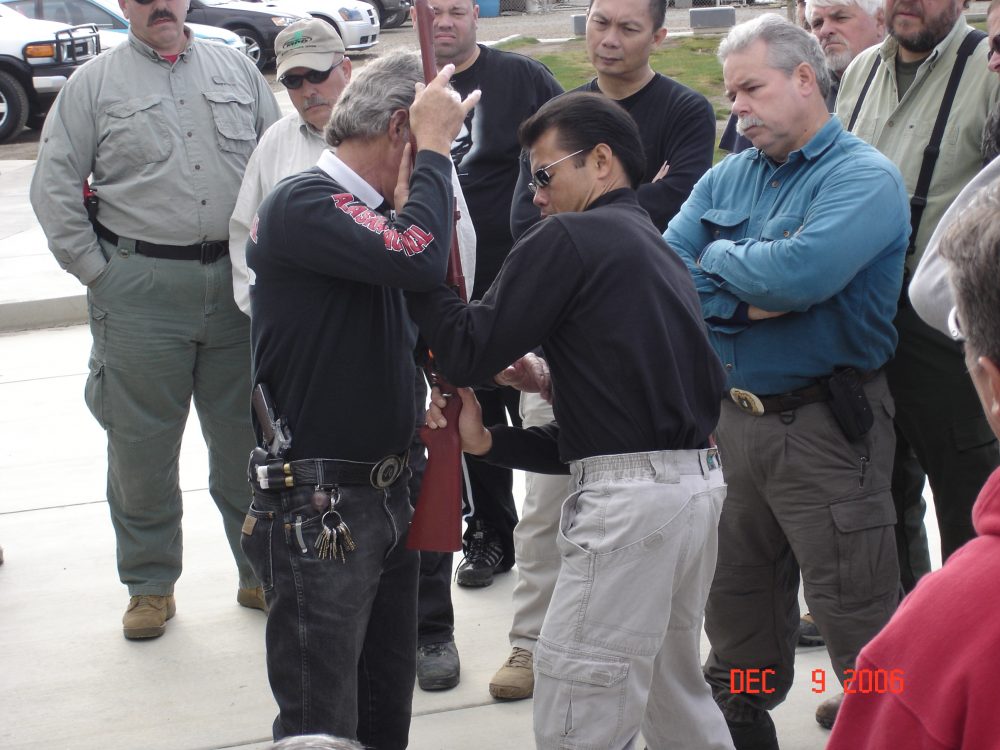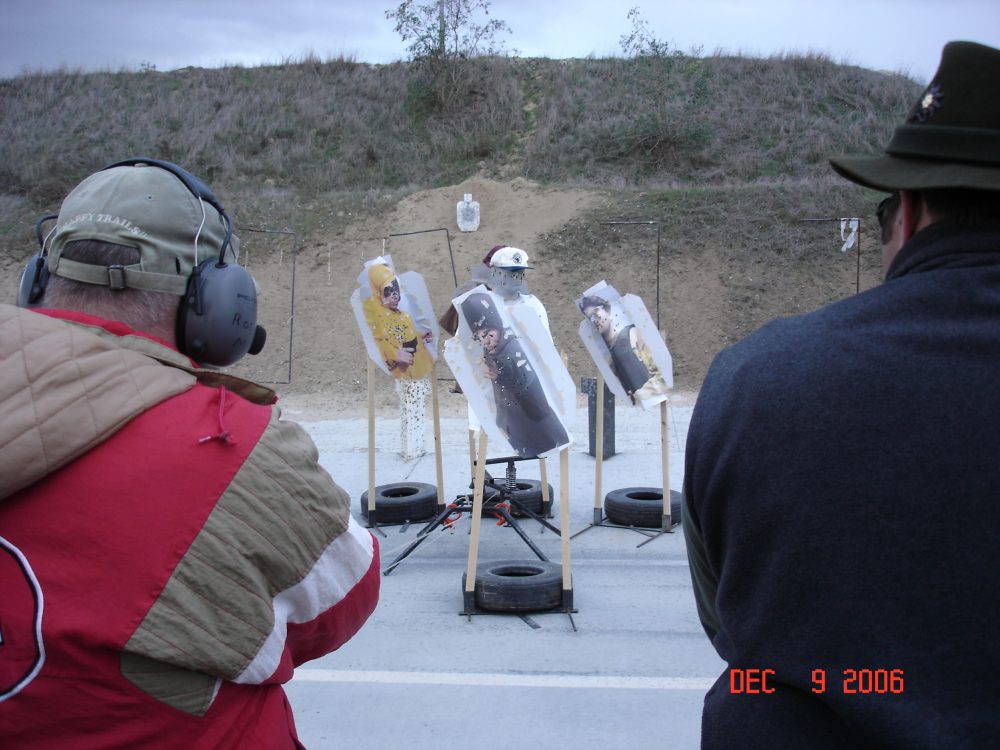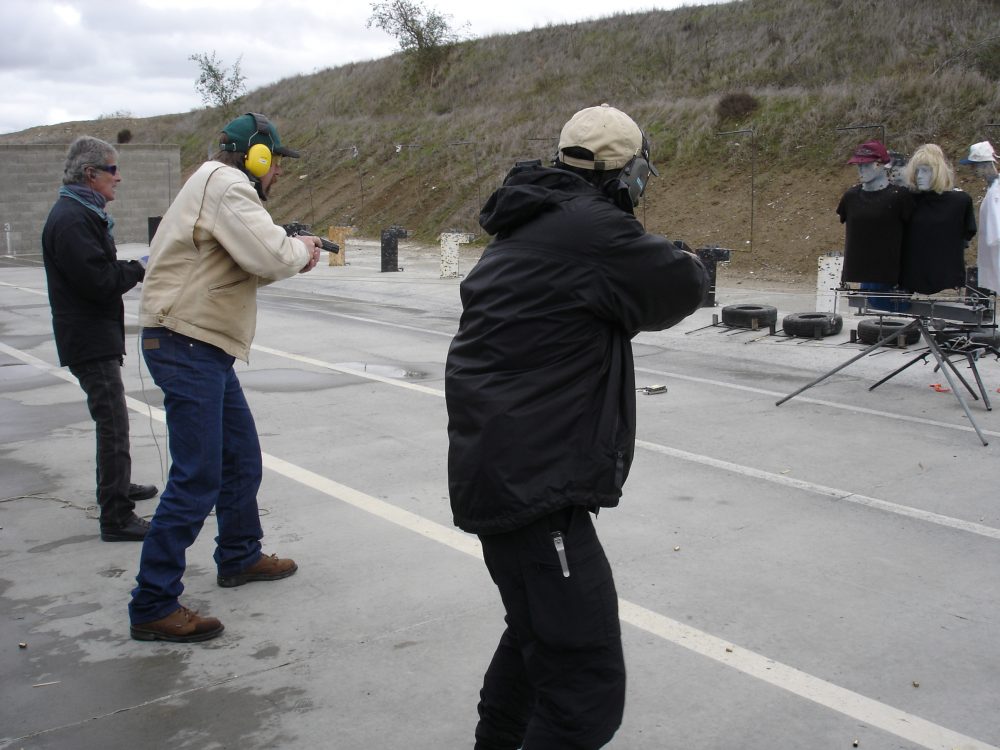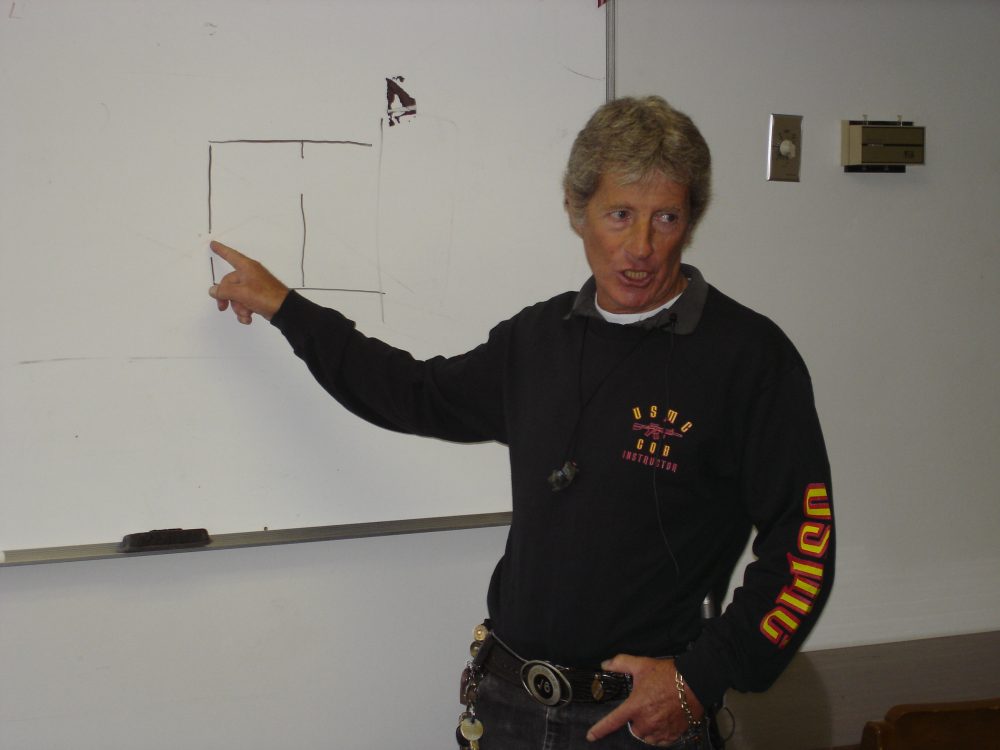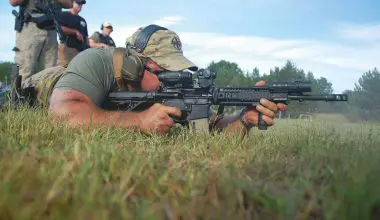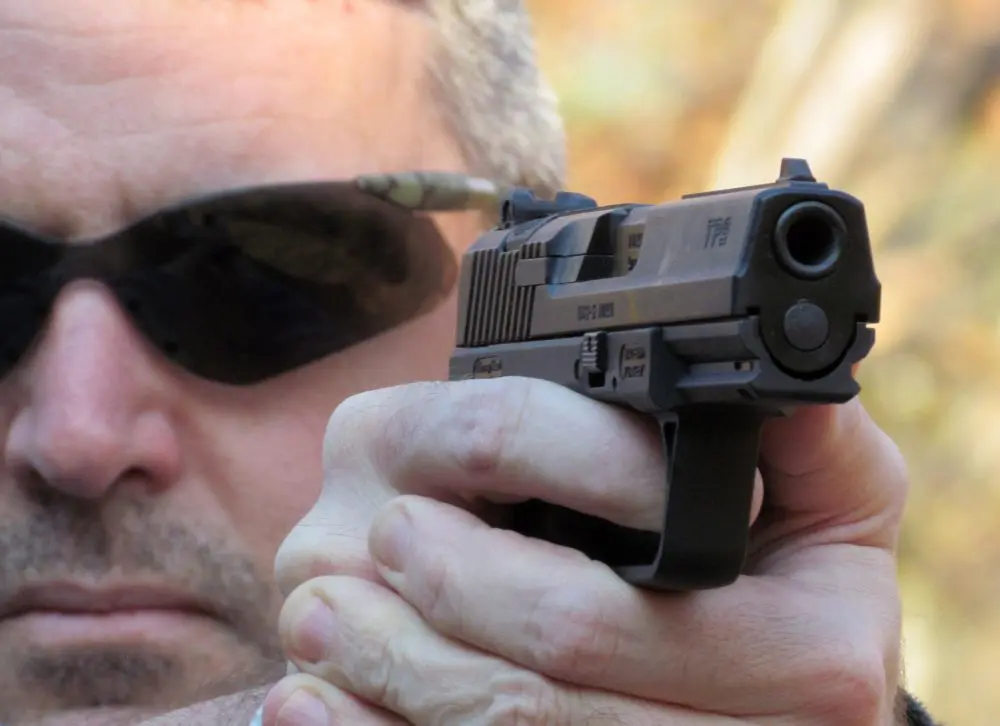Louis Awerbuck coaches student shooting up close and personal while moving off line of fire.
Anyone who has trained with Louis Awerbuck knows that he’s a “thinking man’s warrior.” It is always interesting to get Mr. Awerbuck’s perspective on a combative topic or the flavor-of-the-month gun tactic or gear, because he will always have an opinion and you know that it will be well thought-out. It may not be the way you feel about it, but you will admit that it is a way that is definitely viable—and you might even change your mind.
I’m going to report on an unconventional custom-tailored class that is not in Yavapai Firearms Academy’s catalog of courses. That’s because Louis was asked if he would put together a class to explore one’s close-range weapon potential in an enclosed environment. Emphasis was placed on shooting combatives up close and personal, which so often is the distance where shooting encounters begin. When a gunman has his gun on you up close, do you simply draw your weapon and shoot faster than he does? Is your action going to be quicker than his reaction, even though he has his gun on you? You might not even get your pistol out before he starts shooting. Are you in a gunfight or a fistfight? “Start thinking, gentlemen…”
Vince Bizzini was one of the few participants able to get a full grip on his primary weapon, greatly reducing his time during weak-hand drawing.
Table of Contents
ON THE RANGE
The level of shooting ability was high, since prior training prerequisites were required for attendance. Louis started off with a single head shot. The weather was cold and windy; perfect conditions to start the class cold, and to separate those who were “hot” from the get-go from those who were just warming up.
A relatively close-range head shot might seem pretty simple—until you miss. It happens to everyone, but how are you going to react to the miss? Head shot psychology is just that—all in your mind. In this case, according to Awerbuck, you better go for the sure thing, something you know you can hit fast. If you don’t have the confidence of making the head shot, even up close, you’d better go with what’s going to work for you. “Gentlemen, start using your heads now…”
At the same time, the perfect sight picture was not required to shoot and hit quickly. Whether it was the Cooper Flash Sight Picture or the Cirillo Slide/Cylinder Alignment that the student used for a quick, crude alignment, if he could do it quickly and hit, then why mess with it? At the same time, students experimented with finding the front sight first, then rocking the rear slide up so as to get the rough alignment to make the shot count.
Vince Bizzini was one of the few participants able to get a full grip on his primary weapon, greatly reducing his time during weak-hand drawing.
Since this was a close-range pistol course, all the shooting was done within ten yards. As a result, speed was emphasized. If you and your armed assailant are relatively close to each other, the odds of hitting or getting hit are much greater. You need speed! Furthermore, considering how easily a firearm can be taken away, as the students learned later in the class, close-range shooting has to be fast. Otherwise, your opponent may get his hands on your gun, and then the whole game plan changes.
To address issues with close-range gunfighting, Awerbuck integrates a close-quarters shooting position into the primary drawstroke. After getting a firing grip on the holstered weapon, one simply draws and rocks (rotates) the weapon to the side of the chest. One would be able to shoot effectively from this position at close distances. To continue with a normal drawstroke, one simply gets the support hand onto the pistol and extends the arms to get the gun and sights up to the level where the eyes and the target intersect. If a shooter plans to integrate a palm strike or punch before going to the firearm, it’s crucial that he pull the striking hand back in when drawing the pistol, otherwise he is likely going to shoot himself in the hand, as Simunition training has shown time and time again. Louis pointed out that this somewhat goes against human nature, since the tendency is to keep the assailant at bay by keeping the hand out to maintain distance.
Awerbuck fabricated these simulated weapons for participants to use during takeaway training to prevent injuries. Note various lengths of each item to represent pistols with different barrel lengths.
On the other hand, Awerbuck stressed that in extreme close-range situations, you are most likely in a fistfight, instead of a gun fight. One might not have the ability or time to draw their weapon and must be ready to use their hands to deal with the immediate threat, stressing the need for effective hand-to-hand skills, at least until you can effectively get your hands on your weapon.
Next, what distance is considered close-range? Is 21 feet a safe distance from an attacker? Some law enforcement agencies have extended this distance based on recent experiences with their officers. Awerbuck demonstrated that at 21 feet, initiated by an attacker’s movement, you might be able to draw your gun and get a shot off before he is right on you, if everything goes perfectly: good reactions, no distractions, the perfect drawstroke, decent sight alignment, good trigger pull, etc., tempting Mr. Murphy. Even if you get the perfect shot into the charging attacker’s chest, he may still have fight in him, and now you are simply fighting a dead man up close—he just doesn’t know it yet. What is one to do?
Takeaway tactics and training was covered at the Close Quarters Pistol Tactics Course.
RUN AND GUM? WALK AND CHEW GUN?
Move! Of course, shooting a moving target is difficult, but charging a moving target is even more so. Louis stressed the need for foot movement to get off the line of attack, whether it is in a shooting incident or when an attacker is charging you. Straight lateral movement is recommended given the terrain, but don’t forget that your backstop is going to rapidly change, so you need to keep watch on it. Awerbuck also discussed the advantages and disadvantages of certain ways of moving laterally with and without body armor.
At the same time, students were expected to reload their weapons on their own if they went dry. This was troubling at times for students who were used to loading and manipulating their weapons in static stances, especially when the line was advancing and retreating on their targets.
Gun manipulations were further tested when Awerbuck set up the students’ guns in unconventional conditions. In these cases, when students had to reload, they reverted to what they normally do and not just what the instructor says. In other words, if you are using the slide stop to release the slide instead of racking the slide, it’s going to show, no matter how much you’ve been “hiding” it before.
Students watch Awerbuck emphasize finer details of the takeaway with an Airsoft pistol.
The students benefited from the slight tweaks or modifications to conventional gun manipulations that Awerbuck suggested. To deal with the failure of properly seating the magazine, especially with high capacity magazines that have heavy compressed springs, Louis suggested that one may “drop” the gun onto the magazine instead of or in addition to the usual driving of the magazine up into the magazine well with the palm. While it may not be for everyone, it just might save someone’s life.
There was much emphasis on the speed load, since tactical reloading is rarely performed in the real world. As a result, upon observation, reloads on the range during the class were much swifter and more efficient. Awerbuck also advised against loading the gun right in front of your eyes with your arms extended, since you are just giving your gun away to a person with knowledge of takeaways. The same goes for sucking up the gun perfectly centered against your chest.
Louis coaching student in hostage situation using takeaway training devices.
MY MOTHER DONE TOLD ME TO CARRY TWO GUNS
Louis Awerbuck is a strong proponent of carrying two guns. While many may consider it overkill or being paranoid and literally a pain on both sides of your butt, Louis thinks it just comes with the territory, especially when your life depends on mechanical devices. The logic for carrying a back-up gun begins to make sense in light of the close-range topics explored.
This is especially evident when it comes to clearing malfunctions. In conventional training, students typically know what malfunction they are setting up and already know how they are going to clear it. But in the real world, when the gun doesn’t go “bang,” it is going to take much longer to figure out what is taking place and how you are going to get the gun back into action. Even with the advantages that certain weapon systems have in clearing Type 3 malfunctions more quickly, nothing is more efficient than drawing a back-up weapon with a trained weak hand and finishing the job.
Weak hand only shooting was also covered. Participants with only one firearm did not fret. They drew their pistols with their weak hand. One participant was able to get a proper firing grip on his primary weapon with his weak hand right out of the holster. Not many people can do this, and it definitely reduces the time to get the gun into action with the weak hand. Still, even this ability was not as quick as having a back-up gun in a weak-side waist holster.
It is heavily recommended that if back-up gun training is offered in a class, make a serious attempt at it. Even if you think you may never carry two guns, try it out. When you see how much quicker you are on the range, you might change your mind. Make friends with some left-handed shooters. They might let your borrow their gear so that you can try the drawstrokes from the left-handed holsters, and leave one-gun shooters in the dust.
Long-gun tactics were also introduced.
USE YOUR EYES AND BRAIN!
Awerbuck was quite vocal about many of the procedures taught in conventional firearms training. Of course, Louis is the first to admit that everything he says is his own personal opinion, and we all know that one’s opinion really only matters to one’s self. At the same time, Awerbuck gets students to really think about what they are doing on the range, because more often than not, what they do on the range is what they are going to do for real. “Your shooting is not going to get you killed, your tactics are!”
For instance, when students scan after a shooting drill, are they really seeing anything? Awerbuck proves that many times they are not. They may look like they are scanning, but no data is going into the brain. And all bets are off when students go into force-on-force training and nighttime scenarios. Furthermore, demonstrating with students in previous classes, Louis proves that whether you are scanning with your muzzle or just holding your gun in low ready, you are able to get your sights on the target in the same amount of time, especially if you are unsure of which target to shoot in a multiple target situation. You might consider just using your eyes, but truly use your eyes by taking everything in. Does this mean that Awerbuck is against scanning? No, but if you choose to do it, you’d better really be doing it!
Hostage situation with “no-shoot” targets surrounding the bad guy. Bullet holes on no-shoot targets were from earlier training session … honestly. Our class would never have done that. Seriously.
WEAPON DEFENSE AND TAKEAWAYS
To safely teach takeaways, Awerbuck made up several simulated pistols out of modified plastic coat hangers. This served a couple of different purposes. Obviously, participants without a training gun had something to practice with. Without a trigger guard on the training device, students were also less likely to get their fingers broken. Finally, the lengths of each training device varied, since a firearm could be of different barrel lengths. This proved beneficial because one of the primary lessons was to go for the hands instead of the gun. This way, regardless of the length of the barrel, you can get the job done with the same training technique.
Louis made it perfectly clear that there were no guarantees with this training. You may be blinded by muzzle flash and deafened with muzzle blast due to proximity to the muzzle. Furthermore, you will have little control over Rule #4 since you are dealing with Rule #2. Since the gunman has no clue what Rule #3 is, his finger will most likely be on the trigger. As rounds will probably be going off when disarming him, you won’t have the luxury of controlling the safety of the backstop.
Students prepare to take out hostage-taker with South African computer at Awerbuck’s fingertips.
The general training approach included a hand block and body movement to get off the line of fire, followed up with a hand/wrist immobilization and joint-lock or -break to disarm the opponent. Since safety was a concern, joint-breaks were not allowed and dropping your training partner into the cement was discouraged.
Awerbuck showed his preference for certain hand blocks over others, since Simunitions training has shown more “hits” using other types of blocking techniques. Careful attention was also paid to how the students were immobilizing the gunman’s hand, because if the technique was not performed properly, the gunman might be able to turn his wrist and shoot. When asked if you should go for the gunman’s gun, Louis advised against it, “since you have too many things going on in front of you.” Lastly, issues dealing with opponents of various heights as well as left-handed shooters were addressed.
Despite his disclosure that he is not a knife-fighting expert (“The only person I’ve ever cut is myself.”), Louis did a useful short session on knife defense as well. Utilizing the same approach as with firearms, he commented that, despite knives not being as dangerous as firearms because you don’t have to worry about muzzle direction, you are probably going to get cut. One doesn’t have to be good with a knife to be dangerous with it, and almost everyone carries a knife.
Psychologically, Awerbuck mentioned that takeaway strategy goes against most conventional thought with firearm encounters. How many times are we instructed to get distance from the threat? According to Louis, getting in close—close enough to take away the weapon—goes against everything we’ve been trained to do. But that is exactly what is needed to make it happen. One also has to make the psychological commitment before attempting the takeaway. Any amount of tentativeness will get you shot. “If you blow the takeaway, you are going to get shot. You cannot afford to blow it.” When a student began to express some reservations of ever attempting a takeaway for real, Louis reiterated that there is no guarantee. A takeaway is a last-ditch effort and you have to get control of your emotions to make it work.
Louis presents the “scenario” and discusses strategy for the simulated building layout.
FORCE-ON-FORCE
One of the last drills of the course was a force-on-force training scenario with Airsoft pistols. Using portable walls and doors, a structure was constructed for two-man teams to safely clear the rooms and deal with a “player,” potentially a shoot or no-shoot target. Louis prepped the students by setting the scene and presenting some team strategy for moving through the rooms. It was also a great training exercise for controlling one’s muzzle and not sweeping your partner.
Participants were required to take off all the gear that could potentially harm anyone. No telling if someone might use that folder in his pocket. At the same time, Louis advised everyone to go into the scenario as if it were for real, since a problem with using Airsofts is that you know you’re not going to get killed, so you start taking chances. “You have to play it in your head that this is for real, and what would you do for real?”
Two-man tactics were the name of the game, but if one of the partners went down, then the remaining member had to revert to one-man movement. Communication between partners and with the opposing player was discussed. While some scenarios were fast and furious, others required some communication with the opponent.
Suffice to say, each two-man team had unique and valuable learning experiences, whether it was being the point-man or the back-up person, shooting the player when it was not warranted or not shooting the player when it was warranted. One thing was for sure, game plans definitely fall apart in the middle of clearing a room. You could do everything right and still get killed. There are no absolutes and if you lose, there is going to be a lot of second-guessing with “I should’ve, would’ve, could’ve…”
Two-man team clearing room during force-on-force training scenario with Airsofts.
CONCLUSION
People who have trained with Louis Awerbuck know that he holds quality over quantity. During this three-day course, students shot only about 300-400 rounds of ammunition. But this course brought another dimension to the shooter’s world, and the use of Airsofts taught each student many valuable lessons. While it might be more fun to shoot more and think less, it is probably more valuable to think more and shoot less.
Awerbuck is always sure to say that what he advises or professes is his own personal opinion, and each person has to take it for what it is worth. The point here is, keep an open mind when working with a trainer, since you never know if he might have the piece of information or the presentation that helps you get the critical point that you’ve been missing. At the same time, have your B.S. detector on and don’t blindly accept everything a trainer says as the gospel truth—and that may be the most valuable lesson of all.
SOURCE:
Yavapai Firearms Academy
Dept. S.W.A.T.
P.O. Box 27290
Prescott Valley, AZ 86312
(928) 772-8262
www.yfainc.com







